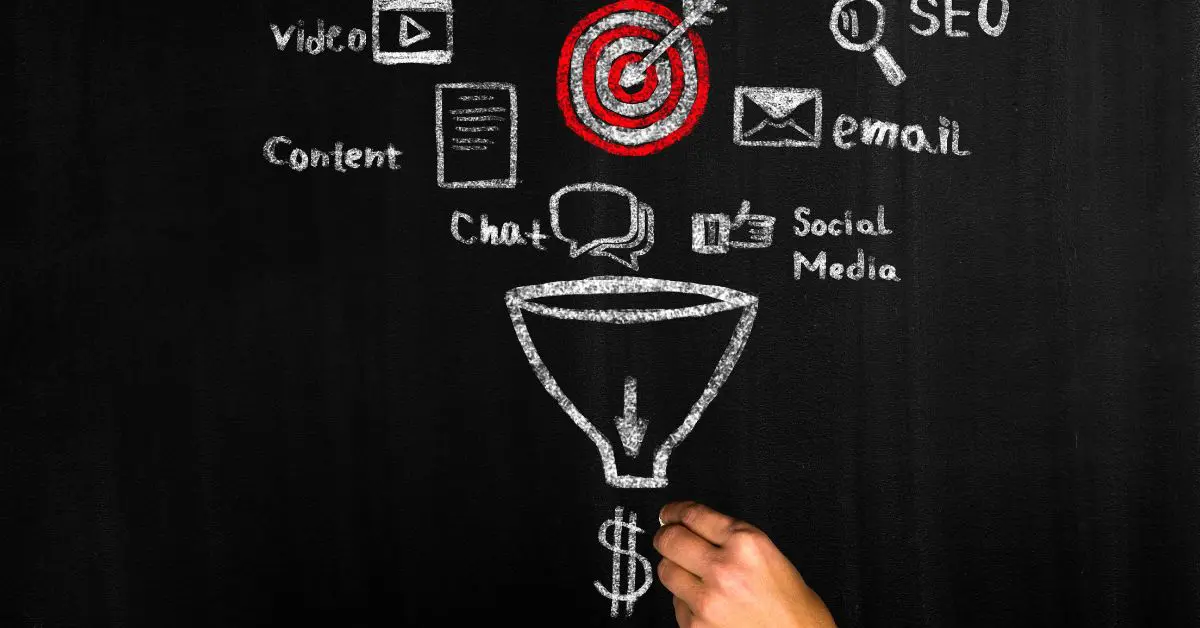Marketing a product is not child’s play. The process of converting a lead into a consumer can be long and needs focused effort. On an average, the whole purchase process can take 6-8 marketing touch points to generate a viable lead. You would have to make sure that your clients are satisfied with your business at every turn. This is where the marketing funnel would help.
The marketing funnel assists in recognizing the stages of your customer’s journey. It spans from awareness to consideration, then action, and finally to purchase.
This article will concentrate on different stages and strategies within the marketing funnel. Further, it will explore how businesses can utilize them to connect with prospects and successfully close deals.

Understanding a Digital marketing funnel
A digital marketing funnel is a detailed mapping of the stages that prospects take to become customers. It aids in identifying the number of leads you generate and assessing the quality of those leads. Additionally, it tracks the actions taken by your customers on the website.
Understanding the funnel is important because it helps you determine what kind of marketing tactics will work for each stage. For instance, to attract more customers from social media, you need to discover the type of content they share. Additionally, determine how frequently they share it and how often they engage with other’s on social media.
A marketing funnel helps businesses in several ways:
- It helps you identify the customers you want to attract and convert them into loyal repeat buyers.
- You can also track how is your content is performing with these customers, so you can adjust as needed.
- It helps you stay on top of your customer’s needs. Therefore, ensuring that you are always addressing their needs with the right content.
- It helps you measure your progress against competitors so that you can see where you stand and make improvements.
- Utilize it to craft targeted ads that appeal to specific groups within your target market. This approach encourages high conversion rates from these groups.
- It aids in building brand awareness by showcasing what your company is about. This, in turn, increases the likelihood of people choosing to buy from you rather than competing companies.

Stages of Your Digital Marketing Funnel
Online marketing is about moving potential customers from awareness to finally, purchase. Marketing experts have divided the entire process into the following steps:
Awareness
The first stage of the marketing funnel is awareness. This is the stage where your brand communicates with potential customers. It transitions them from a state of ‘not knowing’ about your product/service to becoming aware of it. You can begin laying the groundwork for your brand here. Make sure people are aware of what your brand represents. Additionally, how it operates, and why they should care.
Awareness can be created through a variety of methods:
- Online advertising: Search engines, social networks, web pages, and blogs
- Email marketing: Newsletters, opt-in forms, and email templates
- Direct marketing: Print ads, catalogues, and direct mailers
The goal of this stage is to get people to know about your brand. Your aim should be that your brand stays in consumers’ minds. This way, when the time comes for them to make a purchase, they will think of your brand.
Interest
This is where your audience gets interested in your product or service, driving them to take action. In this stage, the goal is to turn awareness into building trust with potential customers. Also, encourage people to visualize scenarios where they can use your product or service.
You can capture the audience’s interest through:
- Creating a digital campaign. You can share detailed information with interested consumers in the form of an e-book or white paper, for instance
- Sharing insightful stories that outline use cases for potential consumers.
- Add clear call-to-action buttons so visitors know exactly what they should do next.
Remember, always provide value and focus on solving the consumers’ needs and problems.
Desire
The desire stage in the marketing funnel is about understanding what consumers need and want. It prepares them for the next stage of taking action. During this stage, you should be able to answer questions like, “Why do people buy from us? What solutions do we provide?”
The more personal stories you can tell, the more likely people will be interested in what you have to say. Therefore, increasing the chances of conversion.
The purpose is to help your audience narrow choices and feel comfortable with your brand. Achieve this by providing enough information for them to understand your offerings.
Action
Indeed, the action stage is the most important stage. It is where you get people to act. However, getting here takes a long journey.
In this step, brands can create a consumer experience to stand out in their category. Importantly, it will help differentiate your good from competing goods. Therefore, having carefully thought-out product pages on the website is crucial. Delivering exceptional customer service is also essential to help customers feel confident about their purchases. This is also the stage to upsell or cross-sell to repeat customers.
Post-purchase behaviour
The process of acquiring a customer continues after the sale, with customer retention and upselling. The main purpose of this part is to keep the customers coming back. However, with a different offer or product value. Customer retention is all about keeping customers happy and satisfied. This can be achieved through various channels such as email, webinars, surveys, and social media posts.
Positive interactions during and after the purchase can influence whether a shopper becomes a repeat client. Regularly engage with customers who have invested in your brand’s goods or services to build loyalty. This can be done through techniques like email nurture campaigns, social media activations, and loyalty programs. The goal at the end of this phase is to have devoted, satisfied clients who will support your brand and remain customers for life.

How to Build your Digital Marketing Funnel Right?
The digital marketing funnel is a set of steps that takes a user from awareness to purchase. The complexity can vary according to the nature of business. However, the idea remains the same -building a suitable funnel. Most marketing funnels are divided into top, middle, and bottom. But, all of these comprise different strategies and techniques.
Top of the Funnel Strategies
The top of the funnel is where a person first sees your product or service. This might be a website, an email, an app, or even a physical location like a store or event. The goal of this stage is to get people interested in your brand. Further, to encourage them to visit more pages on your site. The content that you create at this stage should be simple and easy to understand. You want to avoid anything too complicated. Because, once someone lands on your site, they will want to learn more about you.
Content Strategy
The top of the marketing funnel is where content strategy plays a large part in the success of your business. Here, you build awareness for your product or service. It ensures that you are reaching out to the right audience.
The content strategy should be far-sighted and aligned to your overall marketing goals. This should include goals for your content as well as operationally – what to write, how to write it, and when to write it. Your content strategy should always focus on:
- Creating Original Content
- Engaging through Content
- Sharing Content created by Others
Sharing relevant content and tagging influencers to your content can boost traffic. It can be as simple as sharing an article on Twitter or Facebook. Or as complex as creating original content that tells their story. Relevant content at this stage includes:
- Blog Posts
Blog posts are the basic way to provide information at the start of customers’ search journeys. You can answer FAQs, provide researched solutions, and demonstrate your expertise, for instance.
- Webinar
Webinars, whether live or recorded, are excellent for creating awareness at the top of the funnel. They allow you to share relevant information and education with your audience in an engaging manner. In return for access to the seminar content, potential customers provide contact information, which can be used to nurture them into leads later on.
- Social Media
Focusing on social media as a top-of-funnel strategy is logical, as most online users discover brands through social media or websites. Implement paid social campaigns to boost awareness and generate leads. Further, complement them by engaging and educational organic content.
- Search Engine Optimization
People automatically begin their searches on search engines. This makes SEO, or optimising for search engines, is a crucial strategy for reaching top-of-the-funnel prospects. When doing this, conduct research on the problems your target audience is trying to solve. Identify the questions they are asking and assess the content you currently have (or can create) to address those initial internet searches.
Want to have a detailed look at top of the funnel strategies? Our blog post ‘Understanding the Top of the Funnel Marketing: How It Works‘ has it all! Follow the link to read more!
Middle of the Funnel Strategies
All the attention generated through top-of-funnel marketing is filtered through the middle of the funnel. The goal is to identify the best, highest-quality prospects that will eventually move to the bottom.
The Middle of the funnel promotes a brand to a familiar market. At this stage, audiences are already thinking about the brand. Marketers post content that aligns with this engagement level, assesses prospects’ readiness to purchase, and guides them further in the buying journey.
Content Strategy
The middle of the funnel is where you get customers. This is where you need to make your business easy to find and generate interest in your product or service. Building a website, landing pages, a social media presence, and a marketing plan are crucial for this.
Marketers typically publish content that helps a prospect understand the value of their product. You can demonstrate this value through stories or case studies, for instance. Relevant content type at this stage includes:
- Case Study
Case studies are a method for showcasing your solution to a client’s specific problem. They provide evidence to support your solution. Use this information to reinforce the messaging from your earlier awareness initiatives.
- White Paper
White papers can build confidence and trust with your prospects. They offer more detailed information than case studies, allowing you to highlight specific aspects of your goods or services. It’s a great opportunity to explain how you address issues your audience faces. Consider starting PPC ads to drive targeted traffic to these important mid-funnel sites.
- Email Marketing
Email marketing offers a chance to reach the targeted demographic without having to wait for them to find you. For instance, if you have gathered email addresses, you could nurture those leads here. You can email them a link to a recent blog article that is related to them. It can also be used to provide case studies and white papers.
- Social Media
Although your leads may have found you on social media, your marketing doesn’t need to end there. Share upcoming live videos you’ll be hosting with your audience. Promote your eBooks, guides, well-known blogs, and other information through sponsored social media ads, for instance.
Interested in gaining an in-depth understanding of middle-of-the-funnel strategies? Our comprehensive blog post – Engage to Build trust in the Middle – covers everything you need. Click the link to access further insights!
Bottom of the Funnel Strategies
The bottom of the funnel includes marketing to a narrow, highly qualified audience. This aims to nurture the decision-making process and persuade buyers to make a purchase.
Content Strategy
At the bottom of the funnel, you find prospects most likely to become paying customers. Provide information about your goods and services in this area. Avoid advertising here, as it won’t help generate leads. Instead, use content marketing techniques to attract users to your website. Relevant content type at this stage includes:
- Discount Codes
You might convert some of your audience at this stage of the funnel by providing discount codes. For example, sending an email with a discount code could help close the deal. This is especially effective if you know a potential buyer has visited your website and added an item to the cart without making a purchase.
- Pricing Page
Your pricing page is a crucial tool for conversion. It provides consumers assurance about what they’ll get for their money and helps them budget for your goods or services. Ensure your pricing page is transparent, truthful, and easy to understand.
- Product Comparisons
This stage is the ideal time to provide in-depth product or service comparisons to your leads. Doing this earlier in the funnel may seem forceful and unhelpful.
Keywords like “Product A vs. Product B” or “Brand A vs. Brand B” are excellent for SEO, for instance. It attracts organic traffic to your website.
- Case Studies
Remember, case studies used at the bottom of the funnel should support the final nurturing and persuasion. Categorize them based on how other businesses use your product or service. This helps prospects see success stories from similar industries.
Interested in exploring bottom-of-the-funnel strategies? Our blog post – Ease Decision Making at the Bottom of the Funnel – encompasses all the essential information! Follow the link to read more!
Using a full-funnel strategy is a strong way to grow your business. This approach makes sense in today’s omnichannel world and leads to better results.It can provide up to three times more brand awareness. Additionally, it leads to twice the consideration and two times more purchases for advertisers.




